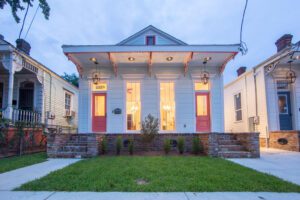Part 1 of the “Le Gens de Couleur Libres” Series
This post is the first in a three-part series exploring Le Gens de Couleur Libres—free people of color—in antebellum New Orleans. These individuals, too often overlooked in mainstream narratives, played a crucial role in shaping the cultural and architectural identity of the city. This introduction offers context for who they were, how they came to be, and the legacy they left behind in the built environment and social fabric of New Orleans.
Who Were the Free People of Color?
Before 1865, free people of color in New Orleans included Africans, Creoles of Color (with “Creole” referring to those born in the New World), and people of mixed African and European descent. Many were born into freedom, while others earned or purchased it. Despite contributing significantly to the economies and cultures of their communities, they were often pushed to the margins of history.
This group occupied a distinct space in antebellum society—neither enslaved nor part of the free white class. Their position created a complex and often contradictory existence. They developed their own culture, traditions, and practices, forming a third class that stirred both admiration and discomfort in wider society.
As one historical account explains:
“Inhabiting this place in between made their ambiguous and incongruent status one of the most talked about ‘problems’ of the first half of the nineteenth century, yet their story has been largely overshadowed by the harsh story of slavery.”
(Free People of Color in Louisiana)
From this space emerged a resilient and influential community—one that included artisans, builders, craftsmen, and entrepreneurs who contributed significantly to the growth of New Orleans.
Plaçage and the Complexities of Power and Survival
A unique feature of free people of color in New Orleans was their participation in the plaçage system. Plaçage referred to socially accepted domestic arrangements between European men and women of mixed heritage. These partnerships began during Louisiana’s early colonial period, when there were few white women in the colony. Relationships with enslaved and free women of color became common.
Even as the colony grew, such arrangements remained socially acceptable. Many of these unions resulted in children, and it was not uncommon for the men—whether white, Creole, or free men of color—to recognize and provide for these families, sometimes alongside families formed through legal marriage to white women. As New Orleans developed, men increasingly took New World–born women as placées.
The Orleans Ballroom and the Role of the Quadroon Balls
One of the most well-known locations associated with this cultural dynamic was the Orleans Ballroom, built in 1817. It became famous for hosting Quadroon Balls, formal events where white men and free women of color could meet and socialize. These balls were seen by some women as an avenue toward economic independence and social mobility.
Despite the legal prohibition of interracial marriage, the plaçage system allowed men to leave property to their placées and children. These gifts and inheritances provided opportunities for women of color to become landowners and businesswomen. Some women chose to remain single after the end of a plaçage relationship, while others entered into new ones or married free men of color. The system was complex, and every relationship unfolded differently.
In 1881, the Orleans Ballroom was repurposed as the convent of the Sisters of the Holy Family, the oldest African American female-led religious order in the United States. Today, this storied space is part of the Bourbon Orleans Hotel, still standing as a monument to layered New Orleans history.

Property Ownership and Economic Power
Relationships forged through plaçage often translated into tangible benefits. Some men remained lifelong bachelors and formed common-law households with their placées. Others maintained separate families and provided financial support discreetly. In many cases, women of color were granted legal ownership of the homes they lived in, either during the man’s lifetime or as part of his estate.
This practice contributed to the unusually high property ownership rates among free women of color in certain neighborhoods. By 1840, femmes de couleur libre owned an estimated 40 percent of the property in both Faubourg Marigny and Tremé. These historic neighborhoods still reflect the legacy of this early Black and Creole landownership.
Many of these women also started businesses, using their economic independence to establish self-sufficient lives outside the confines of traditional roles.
Community, Education, and Preservation of Culture
In the face of systemic discrimination, free people of color found ways to preserve their identity and protect themselves. They formed their own social organizations, hosted private balls, and created networks of support.
Some families sent their children abroad to receive a formal education, investing in future generations despite the challenges of life in a racially stratified society. Although many of their artistic and architectural contributions went unrecognized due to racial prejudice, their impact on New Orleans remains undeniable.

Although free people of color would later be recognized for their artistic and cultural contributions, many of their efforts—especially in shaping the built environment—went unacknowledged due to their African heritage. Future posts in this series will highlight two such individuals: developers whose work helped define the architecture and neighborhoods of New Orleans. Their stories offer a deeper understanding of how gens de couleur libres influenced not just the social fabric, but also the physical landscape of the city.



